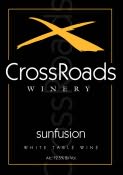 |
|
Wine Details
Price:
Description:
Sunfusion is a wonderful selection of Chardonnay, Sauvignon Blanc and Muscat Canelli, blended together to create an exceptional wine. Intense butter and oak aromas from the Chardonnay, enhanced by the lemony Sauvignon Blanc, with a hint of floral notes from the Muscat Canelli are your invitation to taste this delightful wine.
|
|
|